Over the past 12 months there has been an emerging trend in interiors, which has taken the philosophy of ‘bringing the outdoors in’ to the next level.
Enter Hypernature, which offers super-realistic natural effects using technology to recreate the aesthetics and textures of the outdoors. Director at InHouse Malo Tasle explains: “Hypernature is an exaggerated version of nature, one that never actually existed.
“A little bit more dramatic, greener, more visually intense and sleeker than the original version. As we continue with the drift towards design and materials that harness the beauty of nature, it makes sense that hypernature has become an emerging trend in the kitchen and bathroom market.”
Sponsored Video
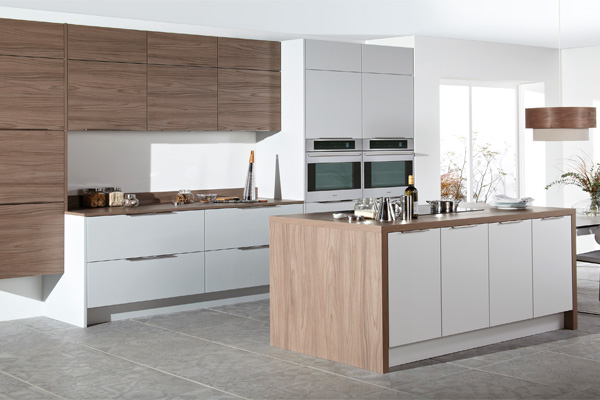
Caple’s Brava features 22mm thick MFC doors which offer a representation of real wood and industrial textures. Shown in Rose Walnut, the doors are also offered in Dark Walnut, Bleached Walnut and Concrete
In fact, kitchens and bathroom spaces are arguably the key rooms in the home which most lend themselves to the hypernature trend, as they are closest to nature.
Architectural projects have frequently transformed a traditional, ground floor kitchen into an open plan design which leads directly into a garden. And the bathroom allows users to directly commune with nature through their experience with water.
Nolte’s regional sales manager for the South West and Wales Eddie Streader comments: “One of things that makes us feel at ease and never gets boring is the world outside, nature. Wood and the colours we’re surrounded with are timeless.
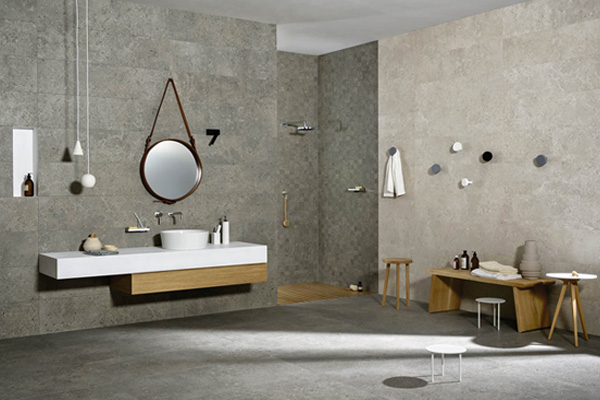
Gris Fleury, from Marazzi’s Mystone collection in Ceramique Internationale, replicates a French Limestone effect. It uses digital printing to create a subtle, varying background and introduces a non-repeating pattern for realism
“I think it’s only natural that these colours and textures find their way into our homes. And I think for the same reason – the kitchen being the hub of the home – you can argue that the kitchen was one of the first rooms to embrace hypernature.”
But, Malo Tasle of InHouse adds: “It’s not just visual appeal that is motivating. Now, more than ever before, we recognise the sense of well-being attributed to nature and the benefits to health and happiness.”
Starting with surfacing
Natural materials such as wood and stone have long influenced the interior styling of a kitchen or bathroom, but the use may have been restricted due to porosity or difficulty of maintenance.
However, with the latest technological developments, materials such as porcelain and quartz have been created to offer the same aesthetics through carefully considered visual and textural replications.
In fact, it could be argued that, through the use of tiling, kitchens and bathrooms have embraced hypernature for some time.

Made from stone resin, TrueStone Rectangular Shower Trays from Merlyn Showering have the appearance of natural stone and come in the choice of White, Slate Black and Fossil Grey. They are available in a range of sizes
Director of Ceramique Internationale Peter Vann comments: “In the tile sector, wood and marble effect – and other natural materials – have actually dominated design for a number of years and are widely used in bathroom and kitchens.”
He continues: “Now tile manufacturers are expanding their repertoire. We’re seeing large format, ultra-thin porcelain tiles that accurately replicate Staturio (chic white Italian marble with darker but sparser veining) and collections that are reminiscent of natural fabrics like hessian.”
And wall and floor coverings have been joined by work surfaces which have used cues from the natural world to create an array of interior looks from industrial through to country styling.
Quartz has been key to this revolution, mimicking natural stones such as granites and marbles, through to engineered versions such as concrete.

Part of Caesarstone’s Metropolitan Collection, Excava 4046 is inspired by the geological decay of stone, weathered by nature with a rough concrete finish. Made from quartz, it is resistant to scratches and stains, heat and cold
Most recently, Caesarstone extended its Metropolitan Collection with the likes of Airy Concrete and Excava. Vice president of marketing at Caesarstone UK Jon Stanley comments: “The industrial movement in contemporary interiors has led to a more robust design vocabulary.
“Tarnished metal, untreated wood and raw concrete are just some of the urban surfaces now penetrating the industry.”
Wondering about wood
But hypernature has not just influenced the surfaces of the environment; it has now made an impact in the construction of kitchen and bathroom products too.
While vinyl wraps, foils and laminates which offer a wood effect for cabinetry may be nothing new, they have now been now been further engineered to enhance realism.
Managing director of Daval Simon Bodsworth offers the example: “Some of our kitchens are designed with the option of being finished in paint grade foil – an exclusive painted wood effect.
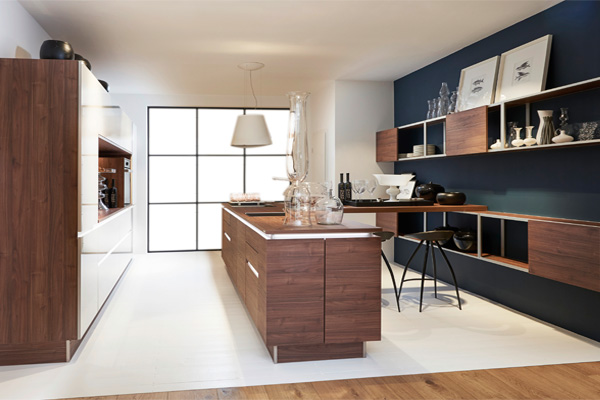
Walnut Royal is one the five décors in the Artwood door range from Nolte, and is now complemented by a matching carcase. As with all Nolte carcases, it has a co-ordinated décor both inside and out
“The laminate door has significant design advantages when compared to a painted veneer cabinet, delivering a greater consistency of colour thanks to its impregnable laminate surface texture and scratch resistant properties.”
While Nolte’s regional sales manager for the South West and Wales Eddie Streader comments that its wood-effect range is so realistic it is indistinguishable from timber: “We launched our Artwood range a couple of years back.
“People could hardly believe that what they were looking at wasn’t real wood but in fact a door range with a very realistic wood décor. Today, this door is one of our best sellers.”
And he adds that, due to its popularity, Nolte has added to the range: “We have introduced a corresponding carcase for the Walnut Royal variant.”
Stone and shells
However, examples of hypernature are not restricted to wooden decors. Similarly to tiles, natural and engineered stone effects are also influencing product designs.
Daval introduced stone effect laminate kitchens – Langham Basalt and Slate – last year. “Each of these hypernature finishes has recently gained momentum within our portfolio, being using in complete schemes.
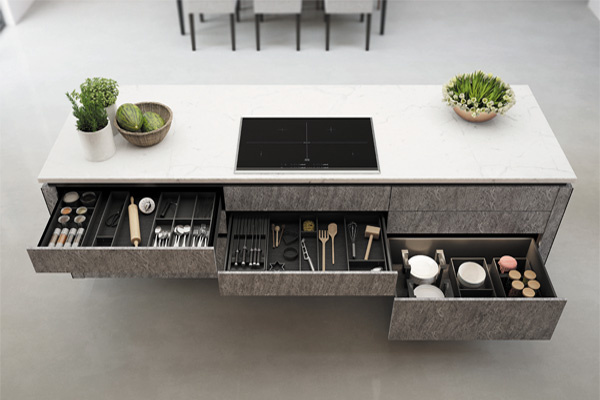
Made from laminate, the Langham Kitchen furniture collection from Daval offers Basalt (shown) and Slate stone finishes in a light to medium grey tone and dark charcoal respectively. In addition, designers can order colour-matched cabinets
“Or, more recently, as a premium accent to other furniture styles and collections we offer.” While for the bathroom, stone effects have been used for shower trays, as well as towel warmers.
In fact, it seems the industry is just at the beginning of a journey to explore the natural world for inspiration. Eddie Streader of Nolte is enthusiastic when he says: “The more realistic finishes there are to get creative with the better.
“Advanced technology has opened up new possibilities here, and it’s nice to explore and see what else is possible.”
Indeed, Bette is already on the path for the next nature influence, having been inspired by ‘mother of pearl’ to create colour with optical depth for its titanium baths and washbasins.
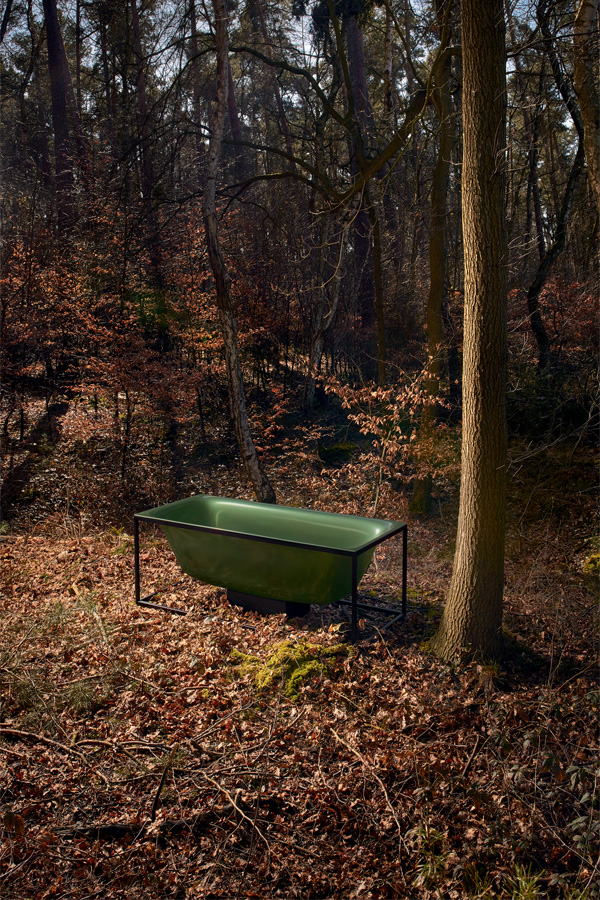
Taking inspiration from iridescent colours in nature, Bette has introduced Forest as one of its Effect colours. Depending on how the light falls, Forest shimmers in shades from green and brown through to violet
Marketing director of Bette Sven Resinghoff comments: “Shells that shimmer like mother of pearl, shiny gold insect carapaces or the glowing colours of autumn leaves – iridescent colours are found everywhere in nature.
“Forest, Bette’s new effect colour, brings some of this shimmering blaze of colour into the bathroom.”
Staple interior style
So is hypernature an interior fad, a just a whimsy of interior writers looking for the next lifestyle trend following the Scandi styling of Hygge and Lagom?
Or are hypernature prints, patterns and textures going to influence the kitchen and bathroom for years to come? Eddie Streader answers: “There will be more of this in years to come because it’s great to mix and match and use these finishes and their texture to define areas, structure the room and combine for effect.”

The Vetro Stone Radiator from Frontline Bathrooms is a frameless, electric model which boasts a travertine stone finish and natural limestone markings for an authentic texture. Fitted with an infra-red programmer and touch screen control, the radiator is available with a choice of two optional towel rails
And although talking about tiles, Peter Vann could be talking about the bathroom and kitchen holistically, when he concludes: “The natural effects are not solely about the aesthetic.
“They are about practical applications – creating the effect of wood, limestone, marble etc, without the installation, cleaning and maintenance issues that the real products can present. So why would consumers turn away from that?”
Kitchens & Bathrooms News recently explored another growing trend: connected appliances.



